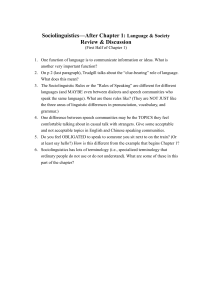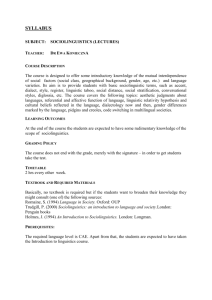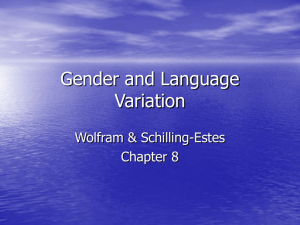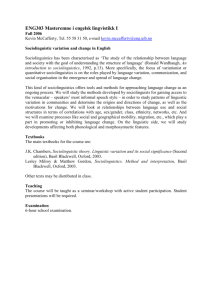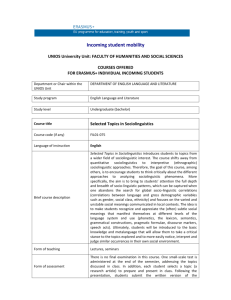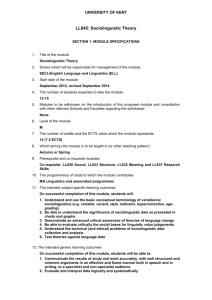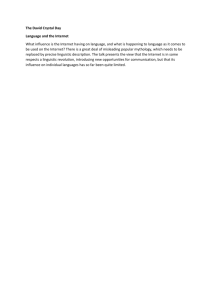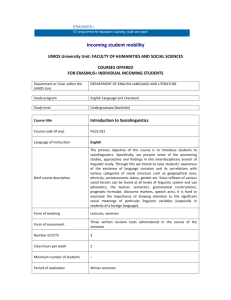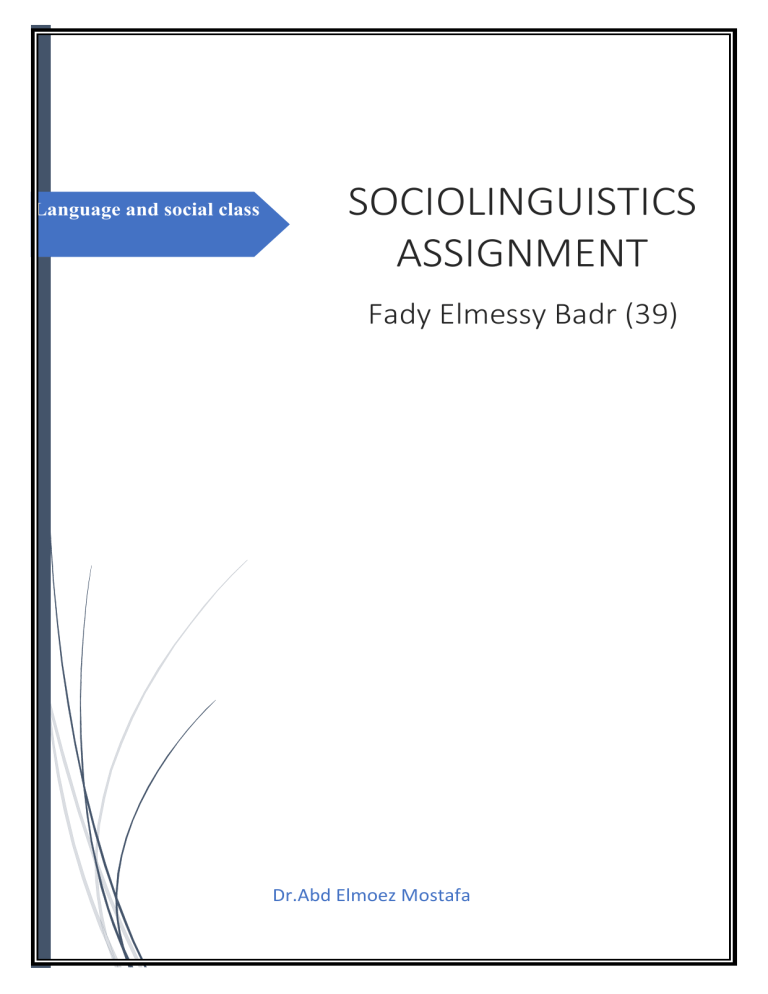
Language and social class SOCIOLINGUISTICS ASSIGNMENT Fady Elmessy Badr (39) Dr.Abd Elmoez Mostafa Language and social class Introduction In all human societies individuals will differ from one another in the way they speak. Some of these differences are idiosyncratic, but others are systematically associated with particular groups of people. The most obvious of these are associated with sex and developmental level: women speak differently from men, and children differently from adults. These two dimensions of social variation in language are in part biologically determined (e.g. differences in laryngeal size producing different pitch levels for adult men and women), but in most societies they go beyond this to become conventional and socially symbolic. Thus men and women differ by far more in language use than mere pitch. (In fact, even their pitch differences are more pronounced than can be anatomically explained.) Such sociosymbolic aspects of language use serve an emblematic function: they identify the speaker as belonging to a particular group, or having a particular social identity. In many societies some of the most important of these sociolinguistic divisions are associated with differences in social prestige, wealth, and power. Bankers clearly do not talk the same as busboys, and professors don't sound like plumbers. They signal the social differences between them by features of their phonology, grammar, and lexical choice, just as they do extralinguistically by their choices in clothing, cars, and so on. The social groups at issue here may be harder to define than groups like 'men' and 'women,' but they are just as real. They are the divisions of a society along lines of SOCIAL CLASS. Class divisions are essentially based on status and power in a society. Status refers to whether people are respected and deferred to by others in their society (or, conversely, looked down on or ignored), and power refers to the social and material resources a person can command, the ability (and social right) to make decisions and influence events. Differences of status and power are the essence of social class distinctions, and it is these that we will have to examine in order to understand class differences in the use of language. The significance of class for linguistics is rooted in the fundamentally social nature of language: language exists so that people can communicate, not for private, individual pursuits. So language is quintessential a social product and a social tool, and our understanding of any tool will be immeasurably enhanced by a knowledge of its makers and users and uses. If class is one of the main organizing dimensions of society, then this fact should be reflected in the evolution and utilization of language. Central problems Class is involved in the description of language use for the most obvious of reasons: the existence of social variation in language. Linguists have not yet achieved even a minimal observational level of adequacy in respect of sociolinguistic variation, and class will be an important dimension in the organization and explanation of these facts. Class is involved in the study of language change because of the long-recognized link between social change and linguistic change. Many linguistic innovations can now be shown to have been socially motivated, to have originated in a particular class, and to have spread through society along predictable social lines. And class is relevant to the construction of linguistic theory because of the relevance of sociolinguistic variation to the definition of the object of study and the competence-performance distinction. The 'orderly heterogeneity' which appears in class variation in language use reveals a communicative competence. Defining class One of the problems facing researchers dealing with these issues is the definition of class. While our social intuitions about differences in status and power may enable us to distinguish professionals from unskilled laborers, or white-collar workers from blue-collar, they are not adequate for empirical research. More objective definitions of the categories are required. While such definition is fundamental to our enterprise, it is hardly uncontroversial. A variety of approaches to the problem have been taken, using as measures of class such things as wealth, income, education, occupation, place of residence, and so on. Class and status The major alternative to a Marxist definition of class focusses on social unity and status more than on conflict and power. This view sees class as a relatively continuous scale on which individuals are ranked according to assorted personal characteristics such as level of education, income, occupa-tion, etc., which collectively imply a certain degree of social esteem. Since the one status hierarchy encompasses all of society, this viewpoint emphasizes social unity, implying that all groups share common social evaluations in terms of prestige and behavioral norms, and perhaps even common goals and aspirations, in the sense that everyone knows what it means to get ahead (principally to make more money) and how one is supposed to go about doing so (work hard, save money, etc.). Class con-flicts are minimized, individual competition is emphasized. The distribution of socially symbolic characteristics such as sociolinguistic variables should,from this standpoint, be relatively gradient, finely stratified, without the sharp breaks in the social. Defining class in nonindustrial economies The studies we have cited so far deal with speech communities in advanced industrial countries, all characterized by similar capitalist economies and class systems in which the major actors are an urban working class, a professional/managerial/white-collar middle class, and a capitalist upper class. What about countries with different economies and class profiles? How is class to be defined there and what relationship does it have to language? These problems are not as well understood, but some relevant work has been done. The social and economic structures of the nations of the 'third world' show several important differences from those that we have been considering. One is that most have a comparatively tiny industrial sector, and a proportionately much larger agricultural sector. Socially this means there is a large class of peasants and landless agricultural laborers (most with little or no formal education), and a relatively small industrial working class. It also means that until quite recently most of the population has lived in the countryside. In the last two decades many third world countries have undergone explosive urbanization, but there is still a much larger fraction of the population living on the land than in the USA or Europe. Linguistically these facts have a number of implications. In the first place, the number of 'nonstandard' speakers is vast, typically constituting a large majority of the population. Second, urbanization is bringing together people who speak many different dialects (or even different languages), creating a linguistic cauldron unparalleled in the industrial world. Thirdly,the extremes of class (wealth and poverty) and the ethnic diversity of many areas means that the range of sociolinguistic variation (the degree of difference between standard and nonstandard varieties) is much greater than we are accustomed to working with in the more homogeneous industrial nations. Class and other social dimensions Another challenge that confronts us in defining class is the interaction between this and other social dimensions, such as race, ethnicity, and sex. Class involves differences in prestige and power. If men and women, or blacks and whites, are differentiated by prestige and power by virtue of their sex or race, then separating these effects may be difficult. A number of studies now exist showing that men and women at the same social class level do not necessarily behave linguistically in parallel ways. For example, in Guy et al. 1986, which describes the social distribution of an intonational change, there is a sharp split between men and women in the lower working class (illustrated in Figure 2, see below, p. 59). Women at this level show the highest rate of use of this innovation, higher than any other portion of the sample population, while their male counterparts show a very low rate of use - not only less usage than any of the female groups, but also substantially less than upper working class men. Class and language change One of the most important areas in class and language studies is the descrip-tion and explanation of linguistic change. Some of the oldest questions in linguistics are how and why languages change, and the best answers often come from outside a language, from the social history of its speakers. The history of English cannot be understood without reference to the Norman Conquest, nor the genesis of Creoles without reference to slavery. Thus in so far as class is an issue in social change, it is an issue for historical linguistics. The essential questions are: 'Which social groups originate changes?' and 'What is their motivation for doing so?' The first question presupposes one fact which should perhaps be made explicit: namely that innovations are not adopted uniformly and simultaneously across society; rather, some groups are innovators or early adopters, while others lag behind. This clearly means that linguistic change involves social variation: at a given point in time in the course of a change there will be some members of the speech community using the new form and some using the old form. In fact, it is likely that many individuals will vary in their usage, alternating between old and new forms, perhaps influenced by audience, social context,etc. Given these facts, who are the innovators? Most answers to this question have been phrased in terms of social class. One idea that received a certain currency was that members of the dominant class originate innovations, motivated by an elitist desire to set themselves apart from the masses (the'flight of the elite'). Such changes would spread because people with the highest status are the ones that others are most likely to emulate. This theory may account for some historical changes, such as the spread of innovations from dominant social centers in medieval European languages (e.g. the spread of Parisian French - the language of the French court -across France). But in modern sociolinguistic work one striking fact emerges: not a single case has been recorded of untargeted innovation originating in the highest social class! Those few cases identified in the literature of changes in progress starting at the top all involve the borrowing of some external prestige norm, i.e. targeted change. An example of such a targeted change introduced from the top is the consonantal pronunciation of post-vocalic /r/ of New York City, discussed above, which is being imported into NYC English from the socially dominant 'General American' dialect. The agents of this change are the upper classes. The important thing to notice is that this 'innovation' does not bring anything new into the language, but just involves dialectal redistribution of variants. Trudgill’s model of social class and language variation in Great Britain An influential conceptualisation of the relationship between regional and social variation in British English is that of Peter Trudgill (2000, but first proposed in the first, 1974 edition). It is shown in Figure 1, which represents variation in phonetics (a similar diagram exists for grammatical variation). It recognises the fact that the amount of regional variation in English is much greater among people of lower social status than higher. This means that it is possible to tell more precisely where someone comes from if they are working class rather than middle class. It also shows that people in the middle of the hierarchy sound more alike across the country than do people at the bottom. Turning to people at the very top, we see that many of them speak a variety which, by definition, shows no regional variation at all: Received Pronunciation (RP) Trudgill’s model works poorly in other English-speaking countries, notably Australia and New Zealand where there is little regional differentiation, class differentiation being relatively more prominent (Gramley & Pätzold 1992: 396, 405). This is true also of those parts of Canada and the USA where European settlement has been relatively recent, say, from the middle of the nineteenth century. Areas along the eastern and southern seaboard, from Newfoundland to Texas, were settled earlier and show much more regional variation in working-class speech, partly reflecting differences among the original English-speaking settlers, but also differences which have arisen in the mean time. References: • Argyle, Michael (1994). The psychology of social class. London: Routledge. • Barnes, John A. (1954). Class and committees in a Norwegian island parish. Human • Relations 7: 39–58. • Beal, Joan (2006). Language and region. London: Routledge. • Bedisti, Eleni (2004). The influence of social class on the language of school children • in Greece. PhD thesis, University of Reading. • Bernstein, Basil (1971). Class, codes and control, Vol. 1. London: Routledge and • Kegan Paul. • Bourdieu, Pierre (1988). Language and symbolic power. Cambridge: Polity. • Cheshire, Jenny, Sue Fox, Paul Kerswill and Eivind Torgersen (2008). Linguistic innovators: the English of adolescents in London. Final report submitted to the • Economic and Social Research Council, February 2008. • Cheshire, Jenny, Viv Edwards and Pam Whittle (1993). Nonstandard English and dialect levelling. In James Milroy and Lesley Milroy (eds.). Real English. • The grammar of English dialects in the British Isles. London: Longman • Milroy, Lesley & Matthew Gordon (2003). Sociolinguistics. Method and interpretation. Oxford • https://www.cambridge.org/core/books/abs/linguistics-thecambridge-survey/language-and-socialclass/33B942C39ABAAF5A4586DAB0A2975044 • Coulmas, Florian (2005). Sociolinguistics. The study of speakers’ choices. Cambridge: Cambridge University Press.
